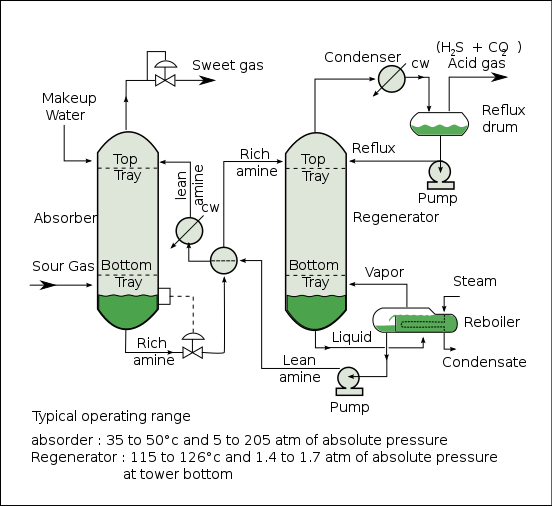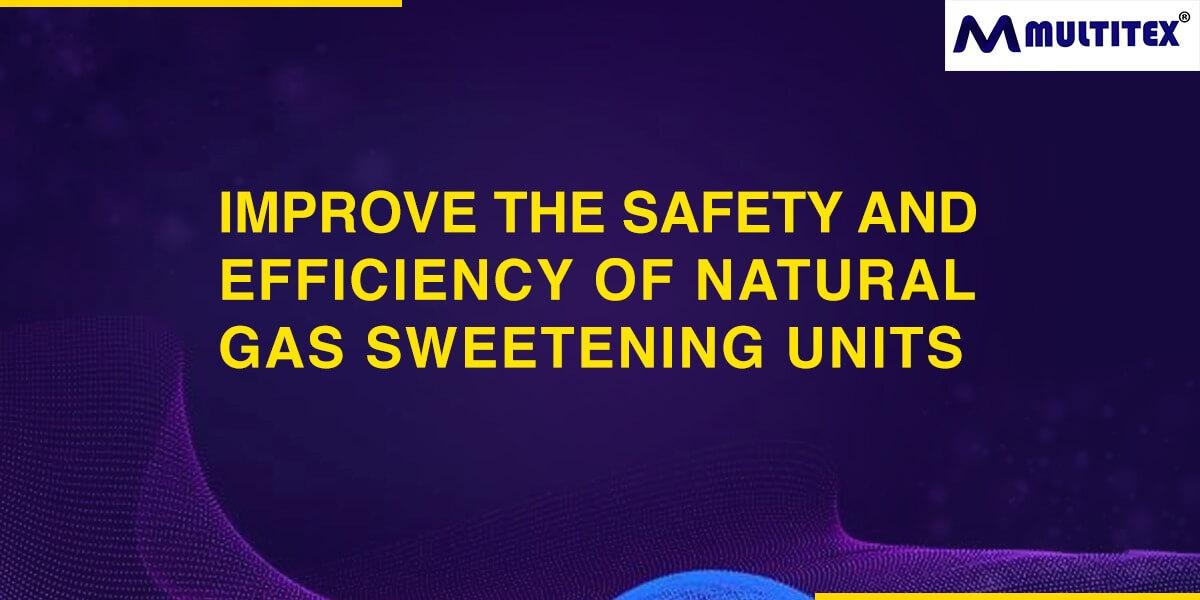What Is Gas Sweetening?
Gas sweetening is a normal process that converts raw natural gas extracted from the ground into a usable form that can be stored and transported easily. Gas sweetening units are employed to convert sour gas extracted from the ground into sweet gas that is safe and stable for distribution.
What are sour and sweet gases?
The raw gas that industries extract from the ground cannot be directly sent over for consumption. It needs to have certain specifications in terms of composition.
Usually, such raw gas is called sour gas when it has more contaminants. Sour gas contains more than four parts per million of hydrogen sulfide (H2S) by volume. Sour gas may also contain carbon dioxide (CO2) contaminants.
Hydrogen sulfide is a common contaminant of natural gas, and it makes gas unstable and dangerous to transport.
Sweet gas contains only traces of CO2 and H2S and is stable and pure enough to be transported and distributed. Sulfur is acidic in nature, and since acid is removed from the gas, it makes it sweeter and hence the name.
Gas sweetening is the process of removing hydrogen sulfide, carbon dioxides, and other chemical contaminants present in gas so they can be used. Gas sweetening units are integral parts of natural gas refineries to convert sour to sweet gas.
The sweetening process is also crucial because sour gas can damage the processing equipment of these refineries and lead to corrosion. Human interaction with sour gas can be dangerous as the gas is toxic. That is why the sweetening process happens as the very first stage after crude gas is extracted.
Here are the actual steps in natural gas sweetening.
Initial Processing
Apart from H2S and CO2, sour gas also contains water contaminants. Water definitely needs to be removed because it has the risk of freezing while flowing downstream. If water freezes, the gas freezes with it too and can get stuck halfway in the pipe.
Water creates water vapor, and vapor mixed with the gas can weigh down the gas and increase its heating time. Water and gas contaminants can mix and lead to abrasion and damage the pipes. Water is removed initially using dehydration, while H2S and CO2 are removed from the gas using the amine treatment process.
Amine Treating

Amine treating is another vital part of gas sweetening units. While water and water vapor is removed in the dehydration stages, H2S, CO2, and other harmful contaminants are removed from the gas in the amine treatment stage.
Amines are organic compounds that are derived from ammonia. An amine treating unit helps effectively remove these contaminants and prepare the natural gas for the next steps.
There can be different types of amine treating units depending on how the refinery unit wants the contaminants to be removed. In some cases, all pollutants could be removed simultaneously, while in other cases, they could be removed one by one, through a series of steps.
A typical amine treating unit has the following parts.
- Inlet and outlet pipes
- Contactor
- Amine flash tank
- Heat exchangers
- Regenerators
- Reflux accumulators
At the end of the amine processing, the outlet gas should be sweet and have minimal or nil contaminants.
Gas Quality Measurements
Without a doubt, the efficiency of gas sweetening units depends on the quality of gas that comes out of the unit. You will be able to know how much contaminants have been eliminated by comparing the quality of inflow vs. outflow gas.
Now, it may sound easy to make these comparisons, but measuring gas quality is challenging for a few reasons.
- Variations in steam composition create changes in measuring values
- Liquid carryover creates problems in precise measurements
- Old-school gas quality measuring processes have high maintenance involved
There are different ways of measuring gas quality, and each of these come with their own pros and cons.
One way of measuring H2S levels in the gas is using a lead acetate tape analyzer. This tape is used to measure the amount of H2S in gases that come out of gas sweetening units.
Such tapes are coated with lead acetate and are exposed to the gas that flows out. The more H2S in the gas, the more brown stains the tape would get. This is an easy method but maintaining the analyzer takes time and effort. Also, you cannot precisely calculate the amount of H2S in the sample and there could be false positives too.
Some refineries also use analyzers with UV lights that can detect the presence of H2S. These analyzers may also change responses based on the external environment and are not very popular.
A third method to analyze gas quality in gas sweetening units is to use a piece of equipment called Tunable Diode Laser Absorption Spectroscopy (TDLAS).
TDLAS can be used to measure the exact concentration of contaminants and other additions in gas mixtures. The advantage of this equipment is that it can detect even minuscule concentrations. As the name specifies, this is a laser-based assessment technique. Thanks to its reliability and superiority over other methods, it is still being used in refineries across the world to calculate gas quality.
How to Measure Levels?
These gas sweetening units have something called a contractor. The level of amine in the contractor has to be maintained at all times for the whole setup to work properly. Here is where level measurement components are used. These components indicate when the amine levels go low.
Similarly, all other components like the flash tanks and regenerators also need level measurement controllers to ensure the process goes through right.
The Flow Measurement

It is not important just to measure the quality of gas that flows out. The flow rate also has to be measured. The flow rate of gas and the amine circulation rate both affect the quality of gas that comes out of these gas sweetening units.
Two devices can help in flow measurement.
Multivariable ultrasonic gas flow meter
A device called the ultrasonic gas flow meter can be used to measure these two variables. These flow meters can measure the flow rate of both the wet and dry gases that flow out of the sweetening unit by measuring the temperature and pressure compensations.
The circulation of amine depends on the type of gas that flows in and the concentration of amine. The circulation rate has to be exactly right for the flow meter to work well. Over circulation leads to more fuel consumption, while under circulation lesser absorption and removal of the contaminant gases.
Coriolis mass flow meter
Coriolis mass flow meters are slightly more advantageous than ultrasonic gas flow meters because amine concentration does not affect them. These meters also have a wider turndown ratio, which is also an added advantage.
Temperature Measurement
Measuring the quality and the flow rate are important. So is measuring the temperature. The gas flow temperature has to be measured at different points within gas sweetening units. Here are reasons why temperature measurement has to be precise.
- The liquid desiccant has to be almost at the same temperature as the sour gas to prevent problems like condensation and foaming. The allowed temperature difference in most cases is less than2-7 degrees Celsius.
- The lean amine temperature entering the contractor unit must be perfect to ensure the H2S and CO2 gases are fully eliminated.
- The unit has to control reboiler temperature to prevent water vapor loss
- Excessive heat in the unit can lead to amine loss. This will lead to a constant need for refilling amine, which can turn expensive. So monitoring the proper temperature becomes very important.
When extreme temperature fluctuations occur, these devices should have a sensor that will automatically detect this and switch off the gas sweetening unit. This is very important to ensure no permanent damage to the unit.
Differential Pressure Measurement
Foaming is a common problem in such gas refineries. Excessive foaming could mean that there are excessive of contaminants in the sour gas. Excess of foam is a disadvantage. Foaming can be detected by monitoring the pressure differences in the contractor columns. Similarly, there will be a gradual change in the pressure built up inside the unit if there is excessive of fouling.
Fouling is the build-up of sludge, scales, debris, and corrosive materials in the unit. Too much fouling can bring down the quality of the sweet gas.
Experts in these oil and gas filtration have ample experience detecting such pressure changes and taking appropriate action. There would be pressure monitors with sensors just like the temperature sensors, and this helps switch off operations in case of excessive pressure fluctuations.
How to simplify the process of buying and installing natural gas sweetening units
The importance of gas sweetening units has been clearly established now. The complexity now lies in buying and installing these units. We have seen a lot of components that are a part of gas sweetening units, and if you start ordering for each one from a different vendor, then this will take time, effort, and a lot of complications in getting the system functioning.
If you are an oil and gas refinery, then the mere idea of contacting multiple vendors and getting the system right may blow your mind away. That’s why picking one right manufacturer is important.
Multitex is your perfect partner to simplify the process of ordering, installing, running, and maintaining all the oil and gas equipment that is a part of these sweetening units. We take pride in maintaining strong partnerships with the right vendors, and as a result, your specifications can be 100% matched every time.
Our processes are streamlined, and we have taken up cost-cutting techniques to ensure our clients benefit financially.
Conclusion
For oil and gas refineries, natural gas sweetening units are integral parts that help improve the quality and stability of natural gas. In its raw form, natural gas may have a lot of added contaminants that can make it unstable. Trying to transport or distribute such unstable gas is hazardous. That is why you should be setting up dehydrating and sweetening units at the place where the natural gas is extracted from the ground. Not only is sweetened gas safer to handle, but it is also worth more.
Our experts at Multitex come with decades of experience in the industry. Our processes start from analyzing the customer’s processes, understanding the type of gas to be sweetened, the available space, and the budget, and coming forward with solutions that work.
